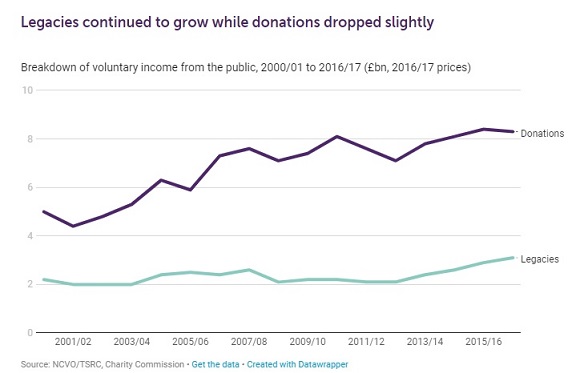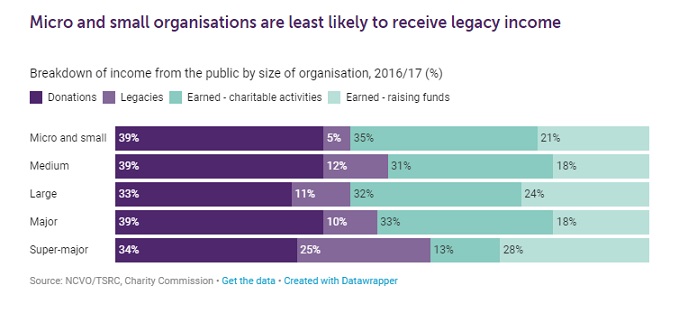 First published in 1996, the UK Civil Society Almanac is the definitive resource on the state of the voluntary sector.
First published in 1996, the UK Civil Society Almanac is the definitive resource on the state of the voluntary sector.
Two main resources from the public
The public accounts for almost half (45%) of voluntary organisations’ total income.
- Voluntary income: half of the money from the public (50%) is ‘voluntary income’ in the form of donations, such as bucket collections or direct debits, and legacies – money that people give to voluntary organisations in their wills.
- Earned income: the rest comes from ‘earned income’, where people get something in return. It encompasses ‘income from charitable activities’ like fees paid for goods and services, membership subscriptions, etc.
 Major trends
Major trends
Income from the public has seen a slight dip for the first time since 2008/09.
Legacies continued to grow while donations dropped slightly.
Donations from the public fell slightly by 2%, from £8.4bn to £8.3bn. They represent 16% of the sector’s total income.
Split by size
Voluntary income
The public are the largest income source for voluntary organisations of all sizes.
Micro and small voluntary organisations receive 59% of their income from the public, while this proportion is lower for larger organisations (41%-48%).
Despite an overall drop, income from the public was up for super-major organisations (due to significant growth in legacies) and large voluntary organisations, for which income from the public grew across all types (donations, legacies, earned). Legacies
Legacies
Over the last five years legacies have grown by 50%.
Legacy income was up across organisations of all sizes, except for major organisations (£1 to £10m).
The rise in legacy income might be linked to changes in financial reporting as much as a real trend.
Although legacy income has grown overall, micro and small voluntary organisations are least likely to receive money from the public in that way.
Only 5% of money from the public was in form of legacies for these organisations, while this was 25% for super-major voluntary organisations in 2016/17.
Donations
The proportion of donations is fairly similar across voluntary organisations of different sizes ranging between 33% and 39%.
Explaining the slight drop in donations
During 2016 donations from the public have seen a slight drop after three years of growth.
However, it’s too early to say whether this will be a continued trend.
Some have been quick to link this drop with falling levels of trust in voluntary organisations.
However, other factors shouldn’t be overlooked.People are being asked less.
_ With the implementation of GDPR, voluntary organisations everywhere have done a huge amount of work to clean and update their supporters databases, with occasional or lapsed donors the supporters most likely to have been removed.
- The way people are doing good is changing. For example, the market for ethical goods and services has grown rapidly over the last two decades and the rise of fundraising platforms and individuals asking directly for support has in some cases removed the role of voluntary organisations as an intermediary, trusted or otherwise.
Explaining the growth in legacy income
Over the last five years, the sector has seen continuous growth in legacy income with the biggest jump in recent years.
This trend can be explained by various factors.
- At death the greatest asset is usually a home and its value dependent on the state of the market. The growth in legacy income since 2011/12 could therefore be linked to a recovering economy and increased property prices.
- The rise in the number of deaths may also be a contributing factor.
- In addition, with the new financial reporting standard FRS 102 legacy income is recognised when receipt is ‘probable’ rather than the previous criteria of "virtually certain". This may have resulted in more legacy income being recognised earlier and contributed to its growth.
- It might further be explained by some voluntary organisations changing their fundraising strategies and increasing their efforts to raise legacy income.
Sources
This article is a summary of a recent on-line publication of the NCVO: 'How much do voluntary organisations get from the public?' (link)











